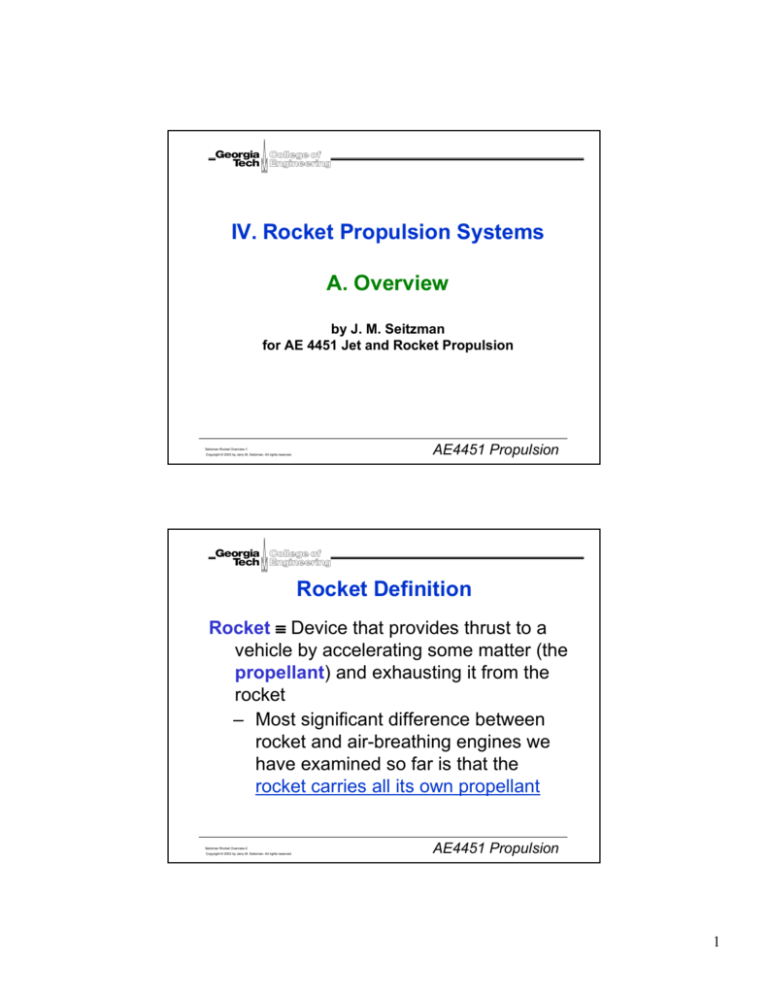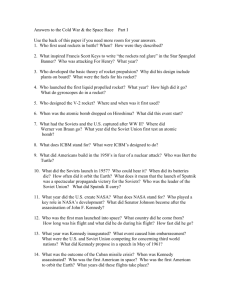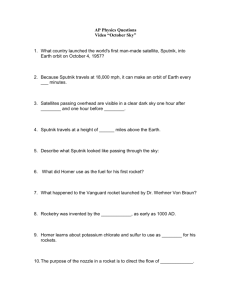
IV. Rocket Propulsion Systems
A. Overview
by J. M. Seitzman
for AE 4451 Jet and Rocket Propulsion
Seitzman Rocket Overview-1
Copyright © 2003 by Jerry M. Seitzman. All rights reserved.
AE4451 Propulsion
Rocket Definition
Rocket ≡ Device that provides thrust to a
vehicle by accelerating some matter (the
propellant) and exhausting it from the
rocket
– Most significant difference between
rocket and air-breathing engines we
have examined so far is that the
rocket carries all its own propellant
Seitzman Rocket Overview-2
Copyright © 2003 by Jerry M. Seitzman. All rights reserved.
AE4451 Propulsion
1
Rocket: Performance Issues
•
Thrust
–
•
important when there are minimum allowable
acceleration requirements, e.g., launch in
gravity field
Impulse
–
•
∫ F( t )dt
measure of rocket performance normalized
by mass of propellant required
Other issues
– structural weight, size, complexity,
reliability,…
AE4451 Propulsion
Seitzman Rocket Overview-3
Copyright © 2003 by Jerry M. Seitzman. All rights reserved.
Rocket Propulsion Elements
Propellant
gas, liquid, solid
Storage
Energy Source
chemical, pressure,
nuclear, radiation (solar)
same in chemical
rockets
Feed System
Storage
Conversion
to press., temp.,
electricity, radiation
for gases/liquids
Accelerator
Thermodynamic (pressure
nozzle), electromagnetic
(static, dynamic fields)
Seitzman Rocket Overview-4
Copyright © 2003 by Jerry M. Seitzman. All rights reserved.
AE4451 Propulsion
2
Examples: Pressure Rocket
• Cold Gas Thruster
⇒Cold gas (N2, hydrazine,…)
stored at high pressure with
thrust provided by acceleration through nozzle
– Propellant=Energy source (storage
pressure)
– Feed system: piping from storage to nozzle
– Accelerator: nozzle (thermal to kinetic
energy)
Seitzman Rocket Overview-5
Copyright © 2003 by Jerry M. Seitzman. All rights reserved.
AE4451 Propulsion
Examples: Chemical Rocket
• Bipropellant: LH2-LOX (H2/O2)
⇒Combust pressurized H2
and O2 in combustion
chamber, nozzle exhaust
– Propellant=Energy source
(chemical)
– Storage: liquid (cryogenic)
tanks
– Feed system: liquid pumps and piping
– Energy conversion: chemical to thermal
energy (combustion)
– Accelerator: nozzle
Seitzman Rocket Overview-6
Copyright © 2003 by Jerry M. Seitzman. All rights reserved.
AE4451 Propulsion
3
Examples: Electrical Rocket
• Ion Engine
⇒Ionize neutral gas (Xe); ions
accelerated by E field;
ions recombined with e– Propellant: neutral gas
– Energy source: e.g., nuclear
– Energy conversion: nuclear to
thermal to electrical
– Accelerator: high voltage
electrostatic field across
electrodes
AE4451 Propulsion
Seitzman Rocket Overview-7
Copyright © 2003 by Jerry M. Seitzman. All rights reserved.
Applications
•
Space Propulsion
–
–
–
–
•
Launch: from “planetary” body to orbit
Orbit Insertion: from launch orbit to mission
orbit
Maneuvering: maintain or change orbit or
trajectory
Attitude Control: orientation of vehicle
Aircraft Propulsion
–
–
High thrust/acceleration (sustained or
boosters)
High speed flight (> ramjet/scramjet capability)
Seitzman Rocket Overview-8
Copyright © 2003 by Jerry M. Seitzman. All rights reserved.
AE4451 Propulsion
4
Chemical Rockets
•
Common Applications
–
–
•
Usual choice for high thrust rockets, e.g,
launch, orbit change, aircraft propulsion
Also used for maneuvering and attitude
control
Monopropellants vs. Bipropellants
–
–
Monopropellants (no separate fuel and
oxidizer, e.g., hydrazine)
Bipropellants (e.g., hydrocarbon/oxygen,
hydrogen/oxygen, nitrogen
tetroxide/monomethyl hydrazine)
Seitzman Rocket Overview-9
Copyright © 2003 by Jerry M. Seitzman. All rights reserved.
AE4451 Propulsion
Chemical Rockets (continued)
•
Propellant Types
–
–
–
–
•
Gas rockets: fuel/oxidizer stored as gases –
requires large storage volumes
Liquid rockets: stored as liquids – more complex
but high impulse
Solid rockets: propellant is solid – lower impulse
but simpler
Hybrid rockets: usually solid fuel+liq./gas oxidizer
Motors vs. Engines
–
–
Motor = propellant stored inside comb. chamber
Engine = storage outside combustion chamber
Seitzman Rocket Overview-10
Copyright © 2003 by Jerry M. Seitzman. All rights reserved.
AE4451 Propulsion
5
Other Rockets: Applications
•
Pressure (cold gas)
– attitude control + maneuvering: reduced thrust
as pressure used up, rendevous
•
Electrical
– Arcjet thrusters - maneuvering + attitude control
– Ion engines - space propulsion
•
Future systems
– Nuclear thermal: like chemical rockets with
nuclear-based heat addition, high thrust?
– Magnetoplasmadynamic and other
electrodynamic devices, high impulse
AE4451 Propulsion
Seitzman Rocket Overview-11
Copyright © 2003 by Jerry M. Seitzman. All rights reserved.
Non-Rocket Space Propulsion
•
•
•
•
•
•
Combined Cycles: typically combine airbreathing with rocket cycles for single-stage to
orbit (SSTO)
Solar sails: use momentum from solar radiation
Magnetic sails: use magnetic fields
Tethers: conducting material moving through
EM fields can produce currents/voltages or
passing current through tether can produce
forces
Gravity assist: sling shot effect
Warp drive…..
Seitzman Rocket Overview-12
Copyright © 2003 by Jerry M. Seitzman. All rights reserved.
AE4451 Propulsion
6








